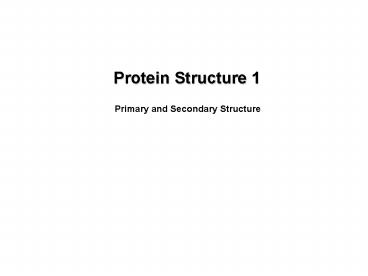Protein Structure 1 - PowerPoint PPT Presentation
Title:
Protein Structure 1
Description:
Protein Structure 1 Primary and Secondary Structure Proteins fold into the local minimum free energy structure defined by their primary sequence. – PowerPoint PPT presentation
Number of Views:26
Avg rating:3.0/5.0
Title: Protein Structure 1
1
Protein Structure 1
Primary and Secondary Structure
2
Proteins fold into the local minimum free energy
structure defined by their primary sequence.
The native structure may not be the global free
energy structure.
Polypeptide chains can assume an infinite number
of potential structures (Levinthals Paradox).
The physical chemistry of the peptide bond and
steric hindrance between the peptide bond
elements restrict the potential structures
assumed by a polypeptide to a finite number of
structures.
3
Hierarchy of Protein Structure
Primary sequence- The amino acid sequence of a
polypeptide, listed from N-terminus to C-terminus.
Secondary structure- Recurring structural feature
of proteins stabilized exclusively by hydrogen
bonds between peptide bond elements.
Supersecondary structure- Recurring structural
feature of proteins composed of two or more
secondary structural elements.
Domain- A segment of protein structure that is
autonomously stable.
Tertiary structure- A stable, independent protein
encoded by a single gene.
Quaternary structure- A complex structure
composed of two or more tertiary structure
subunits.
4
The Electronegativity of the O and N of the
Peptide Bond Results in a Dipole
5
Peptide Bonds Favor the trans Configuration
Except When Proline is Present
poly-alanine (transcis 25001)
alanyl-prolyl (transcis 41)
In cells, prolyl peptide isomerization is
catalyzed by Prolyl isomerase.
6
Resonance in the Peptide Bond Results in
Planarity of the Peptide Bond
Polypeptides behave as a series of plates hinged
at C?.
7
Ramachandran Plots Define the Allowable
Structures Assumed by a Polypeptide Chain
di-Alanine
di-Glycine
di-Alanine
(hard sphere approximation)
(molecular dynamics calculation)
Plot of phi and psi angles for 2500 residues in
13 proteins
Proline dihedral angels observed in protein
structures
after Ramachandran et al. J. Mol. Biol. 7, 95-99
(1963)
8
Types of Secondary Structures
9
Repeating Structures Form Helices
10
Alpha, 310, and Pi Helices
Helical wheel plot revealing amphipathic nature
of helix
310 helix
? helix
? helix
Cylindrical plot revealing alignment of side
chains
11
Side Chain Interactions Provide Additional
Stability to Helices and Signal the Limits of
Helix Formation
Table of helical propensities
12
Parallel and Anti-parallel Beta Sheets
anti-parallel
parallel
13
The Gly-X-Y Repeat Sequence is Essential for
Collagen Triple Helix Formation
poly-proline
collagen triple helix
14
(No Transcript)
15
Reverse Turns Connect Segments of Anti-parallel
Beta Sheets
Type 1 reverse turn
Type 2 reverse turn
310 helix
Always glycine

